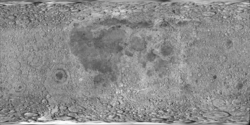Lara (cráter)
| Lara Cráter lunar | ||
|---|---|---|
 Localización de Lara en el valle Taurus-Littrow. El Macizo sur se halla abajo a la izquierda, el Macizo Norte arriba en el centro, y Sculptured Hills arriba a la derecha. La barra de escala representa 5 km. | ||
| Coordenadas | 20°10′N 30°33′E / 20.17, 30.55 | |
| Diámetro | 620 m[1] | |
| Epónimo | Cráter nombrado por los astronautas (topónimo procedente del Lunar Topophotomap) | |
|
Localización sobre el mapa lunar | ||

Lara es un pequeño cráter lunar situado en el valle Taurus-Littrow. Los astronautas Eugene Cernan y Harrison Schmitt lo visitaron en 1972 durante la misión Apolo 17, como parte de la EVA 2. La Estación Geológica 3 se encuentra en el borde noreste de Lara.
El cráter se localiza en el "manto claro", que casi seguro es un depósito de los aludes procedentes del Macizo Sur. Al sur de Lara se hallan el cráter Nansen y la Estación Geológica 2. Al noreste aparecen el cráter Shorty y la Estación Geológica 4.
Denominación
[editar]El cráter fue nombrado por los astronautas en referencia a la protagonista de la novela Doctor Zhivago de Borís Pasternak.[2] La denominación tiene su origen en los topónimos utilizados en la hoja a escala 1/50.000 del Lunar Topophotomap con la referencia "43D1S1 Apollo 17 Landing Area".[3]
Véase también
[editar]Referencias
[editar]- ↑ Lara, Gazetteer of Planetary Nomenclature, International Astronomical Union (Unión Astronómica Internacional) Working Group for Planetary System Nomenclature (WGPSN)
- ↑ The Valley of Taurus-Littrow, Apollo 17 Lunar Surface Journal, Corrected Transcript and Commentary Copyright 1995 by Eric M. Jones
- ↑ «43D1S1(50) Apollo 17 Landing Area». Lunar and Planetary Institute (en inglés).
- (WGPSN), IAU Working Group for Planetary System Nomenclature (13 de febrero de 2013). «Gazetteer of Planetary Nomenclature. 1:1 Million-Scale Maps of the Moon» (en inglés). UAI / USGS. Consultado el 6 de abril de 2016.
- Andersson, L. E.; Whitaker, E. A., (1982). NASA Catalogue of Lunar Nomenclature (en inglés). NASA RP-1097.
- Blue, Jennifer (25 de julio de 2007). «Gazetteer of Planetary Nomenclature» (en inglés). USGS. Consultado el 2 de enero de 2012.
- Bussey, B.; Spudis, P. (2004). The Clementine Atlas of the Moon (en inglés). Nueva York: Cambridge University Press. ISBN 0-521-81528-2.
- Cocks, Elijah E.; Cocks, Josiah C. (1995). Who's Who on the Moon: A Biographical Dictionary of Lunar Nomenclature (en inglés). Tudor Publishers. ISBN 0-936389-27-3.
- McDowell, Jonathan (15 de julio de 2007). «Lunar Nomenclature» (en inglés). Jonathan's Space Report. Consultado el 2 de enero de 2012.
- Menzel, D. H.; Minnaert, M.; Levin, B.; Dollfus, A.; Bell, B. (1971). «Report on Lunar Nomenclature by The Working Group of Commission 17 of the IAU». Space Science Reviews (en inglés) 12: 136.
- Moore, Patrick (2001). On the Moon (en inglés). Sterling Publishing Co. ISBN 0-304-35469-4.
- Price, Fred W. (1988). The Moon Observer's Handbook (en inglés). Cambridge University Press. ISBN 0521335000.
- Rükl, Antonín (1990). Atlas of the Moon (en inglés). Kalmbach Books. ISBN 0-913135-17-8.
- Webb, Rev. T. W. (1962). Celestial Objects for Common Telescopes, 6ª edición revisada (en inglés). Dover. ISBN 0-486-20917-2.
- Whitaker, Ewen A. (2003). Mapping and Naming the Moon (en inglés). Cambridge University Press. 978-0-521-54414-6.
- Wlasuk, Peter T. (2000). Observing the Moon (en inglés). Springer. ISBN 1-85233-193-3.
- «Lunar Impact Crater Database» (en inglés). Lunar and Planetary Institute (USRA). Consultado el 12 de septiembre de 2017.
Enlaces externos
[editar]- Referencia UAI del cráter
- LPI Digital Lunar Orbiter Photographic Atlas of the Moon
- Mapa LROC
- The-moon.wikispaces.com: Lara
 Wikimedia Commons alberga una categoría multimedia sobre Lara.
Wikimedia Commons alberga una categoría multimedia sobre Lara.


